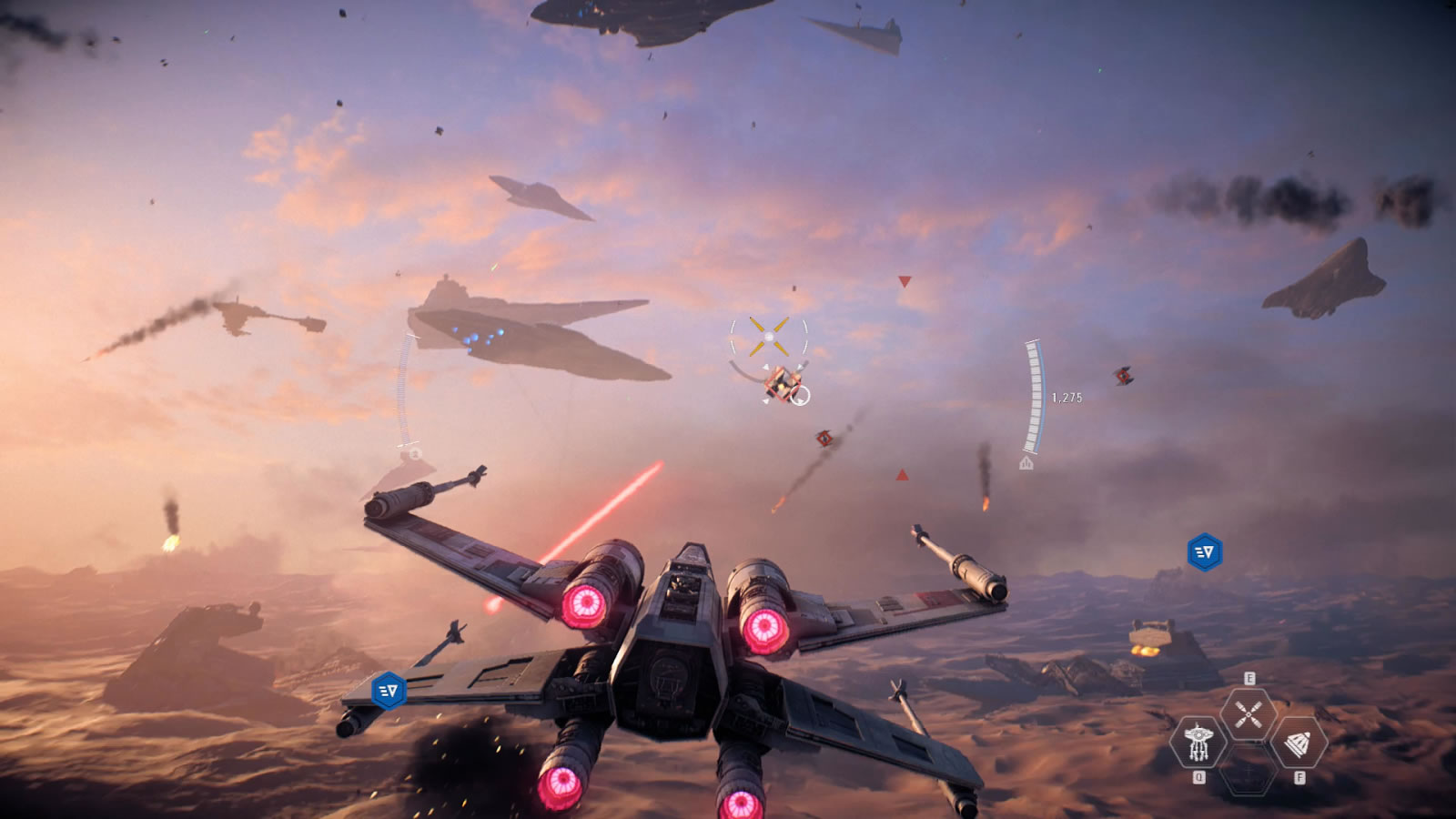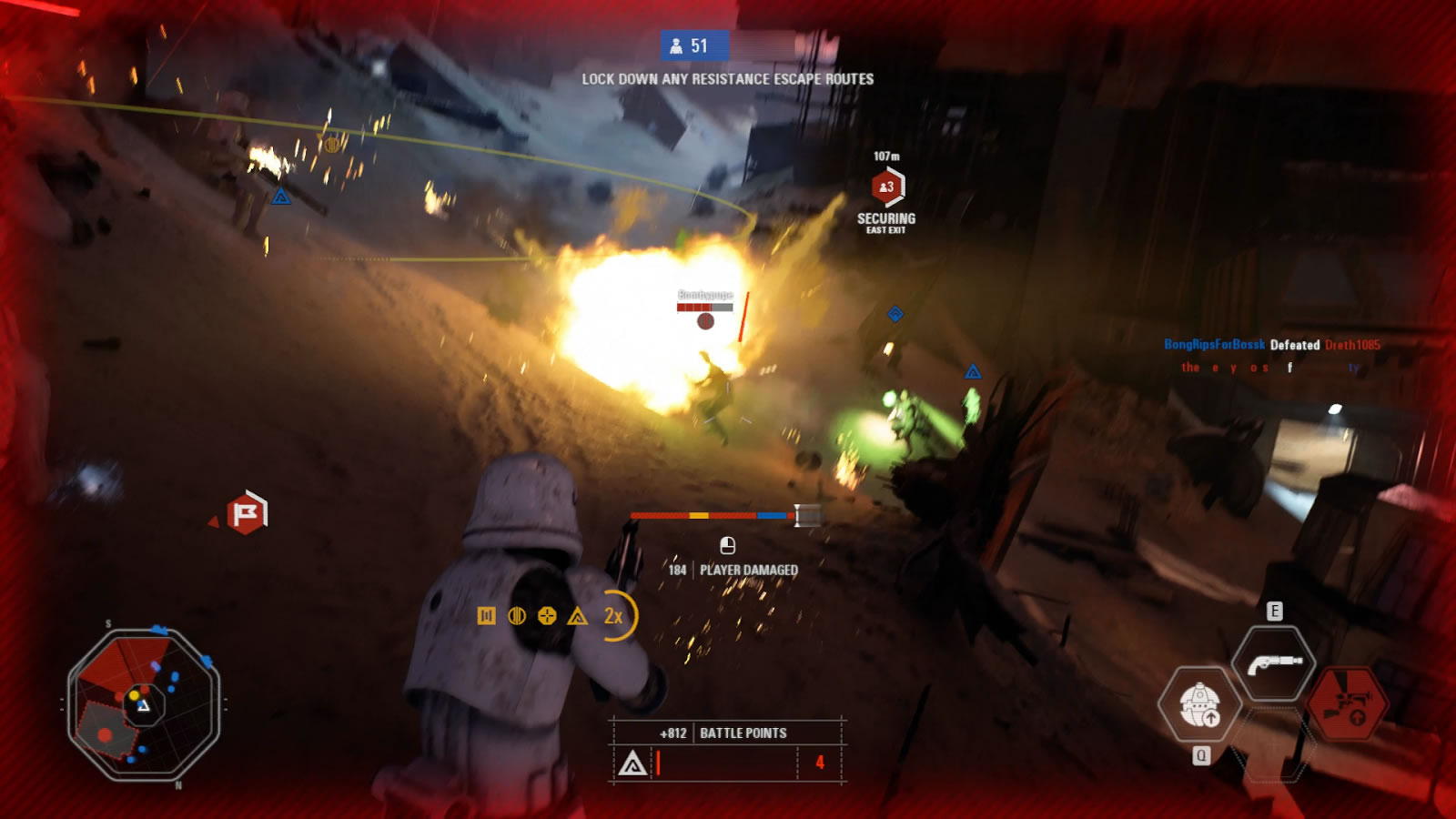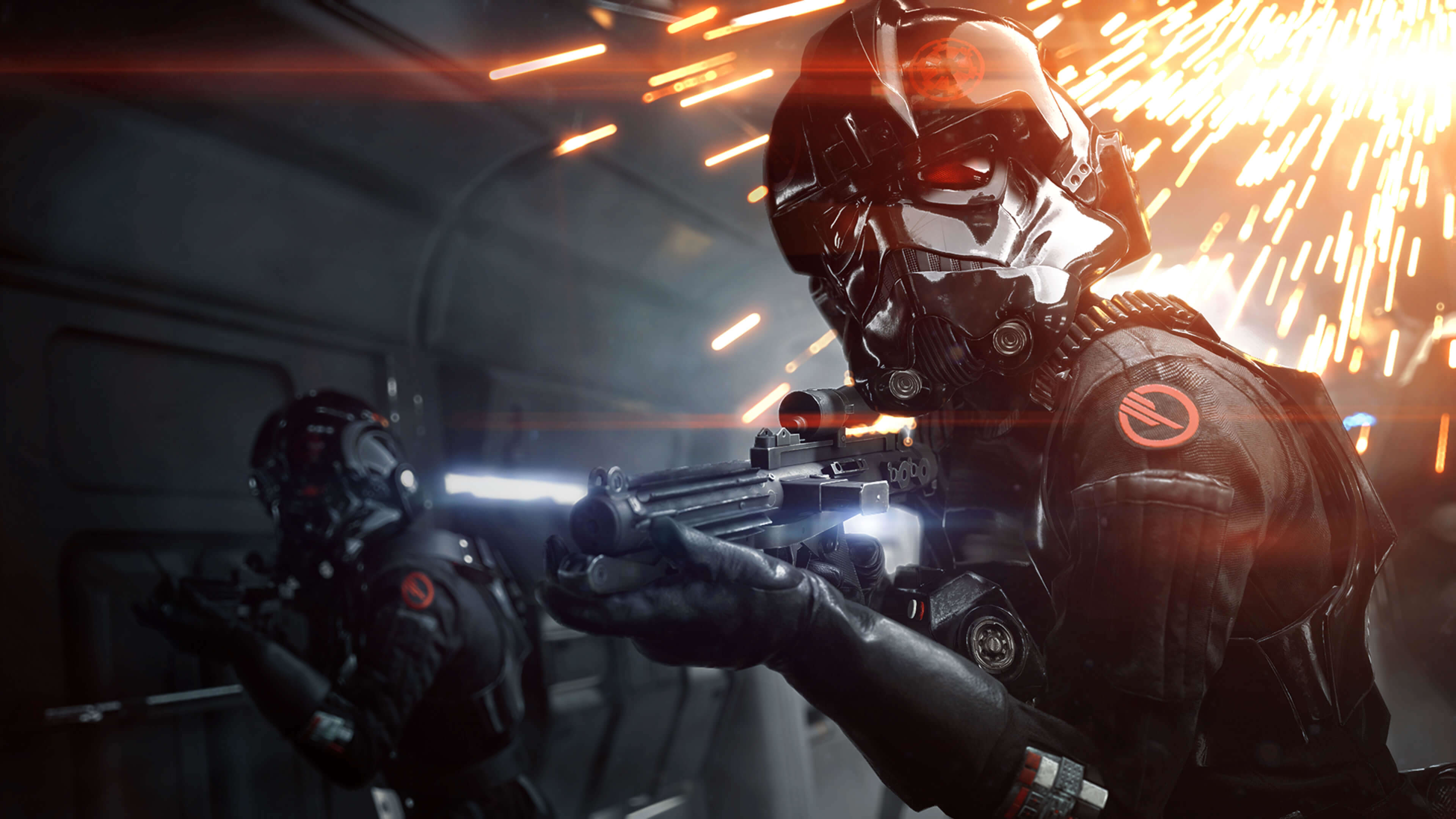 Star Wars: Battlefront II frustrates me in ways I never knew I could be frustrated. It is both a lovingly crafted companion to the films and a tangled mess of corporate meddling. There is a strong heart at the center but finding it means peeling back layers of unnecessary and infuriating nonsense.
Star Wars: Battlefront II frustrates me in ways I never knew I could be frustrated. It is both a lovingly crafted companion to the films and a tangled mess of corporate meddling. There is a strong heart at the center but finding it means peeling back layers of unnecessary and infuriating nonsense.
The multiplayer-centric 2015 Star Wars Battlefront sought to capture the large sci-fi battles that dazzled moviegoers and fans. While it had solid fundamentals and exotic locales, the game lacked the sweeping charm of the source material. It suffered from waves of paid downloadable content that fragmented its audience and the absence of a single player campaign that many fans had hoped for. The makers of Star Wars Battlefront II seek to remedy these failings. While they fixed many of the previous game's flaws, they've created several new ones.
The story campaign follows Imperial special forces soldier Iden Versio and her elite Inferno Squad unit. Spanning the timeframe from Return of the Jedi to The Force Awakens, it initially weaves an intriguing portrait of evil. The Empire has largely served as a rhetorical device in Star Wars, a massive dark force bearing down upon scrappy heroes. Battlefront II takes a cue from material like 1994's Star Wars: Tie Fighter and The Old Republic's imperial agent storyline and opts to humanize the faces behind the stormtrooper helmets. Initially, the story seems focused on slowly investigating Iden's relationship with the Empire but it soon devolves into something clumsier.

To say that Battlefront II's campaign has a story would be generous. Instead, it has a series of moments with the barest relation. The spotlight quickly moves off Iden, resolving her internal conflict with little fanfare to focus on iconic heroes and a far more traditional good versus evil storyline. Star Wars finds strength in its broad, mythic narratives but the shift here feels ill considered. Perspectives jump, scenarios shuffle, and the story hardly gives any moment for things to breathe. When it does slow down, the dialog is snappy and memorable but these moments are fleeting.
Battlefront II settles for excess, crafting a splintered sample platter of interesting ideas and scenarios that never truly delivers. A battle on Naboo dramatically falls back to numerous fronts but feels a bit too much like a multiplayer match. A starfighter battle to destroy world-threatening weapons manages to lack gravitas. The campaign ends suddenly, teasing new content that will release alongside The Last Jedi and resolve loose story threads. Iden's story feels insubstantial as a result, with the conclusion put on hold until Disney gives the green light.

Fortunately, Battlefront II's campaign is enjoyable to play. The campaign loads Iden up with a variety of tools including mini-turrets, a loyal droid companion, and one of the most satisfying video game shotguns in recent memory. While the narrative resolves Iden's personal conflict quickly the gameplay captures who she is on the battlefield. Gunfights are loud and triumphant, asking players to cycle through their gadgets and tools in order to beat overwhelming odds. It is further elevated by astounding visual and audio design that makes every new location as memorable and gorgeous as anything found in the films.
Most of the game's combat takes place on the ground but the brightest moments are the various space and aerial combat segments. Battlefront IImanages to sneak a miniaturized Rogue Squadron into the game with surprisingly little fanfare. Skies fill with fighters and criss-crossing blaster fire, capital ships unleash broadsides, and squadmates chatter colorful barks over the comms. These sequences tease the possibility of a standalone game focusing on rival aces and dastardly Admirals. They are consistently delightful and are invaluable to rounding out the campaign.

Battlefront II's true concern rests in its online competitive modes, but the gameplay there is oddly paced. The game plays much faster than 2015's Battlefront, with faster movement and swift controls adding a ferocity that, while making each battle tense, also makes them feel haphazard. Time to kill is high and it sometimes feels like I need to take one more shot than I'd expect. The clash between fast movement but slow killing is awkward. It looks and sounds intense but what actually happens is less dramatic, like the difference between an airsoft match and an actual warzone. Multiplayer feels a bit like playing an out of tune instrument, as if someone took a Stradivarius violin and pulled the strings too tight. You'll snipe people from across the battlefield only to find that they've brushed off a headshot. You'll throw a grenade into a control point but it'll feel like you were tossing a light snowball. While the main campaign has a sense of weight, the multiplayer action feels distant. After a while, the pieces fall into place and Battlefront II's multiplayer starts to work in spite of these issues but the lead up to that moment is maddening. I've never sworn out loud more colorfully than during the hours I spent wrestling with this game's bizarre multiplayer feel.
In spite of this, there's bound to be one gameplay mode that will capture a player's attention. Battlefront II's largest and most exciting match type is galactic assault, pitting large teams against each other on vast battlefields with varying objectives. The maps span all film eras; one match might have Trade Federation droids attempting to hack computers on the rainy world of Kamino while another tasks Rebel soldiers with escorting a stolen AT-AT walker during the Battle of Endor. A dedicated starfighter assault mode significantly expands 2015's Battlefront's disappointing dogfights by offering various objectives such as destroying a capital ship or clearing mines out of an asteroid field. If these modes ever seem too grand, a wacky heroes vs. villains mode allows players to pit iconic characters against each other in a slugfest, while a scaled down blast mode limits map size to encourage close combat fights.

And yet, all of this is irreparably crippled by the game's progression system. As players level up, they will earn loot crates containing "star cards." These cards do anything from granting new gadgets, buffing attributes such as health, or augmenting abilities with new effects. These are meant to offer a wide range of customization but they instead upset an already precarious balance. Maybe those sniper shots would have killed my enemy if not for their level three health boost. While these crates can be purchased with in-game credits, they can also be purchased with a premium currency that costs real money. Cards earned through these crates can be equipped immediately and while superior play might allow you to best opponents with higher level cards, there's nothing stopping a player from buying $100 worth of currency, buying loot crates, and boosting their statistical advantage. Players don't have to spend to earn these advantages, but the time a player would have to play to gain the same advantages is much longer. There are stopgaps preventing players from crafting cards of higher quality based on their multiplayer rank but lootboxes bypass these limitations entirely. The game at least keeps the rarest cards from lootboxes, which means at least they have to be earned by actually playing the game.

There is no dancing about the issue: this progression system is meant to incentivize players to spend money. Everything flows through these crates; if you want to gain cards or the materials to craft cards, you will need to open crates. Loot crates are, in their very construction, designed to visually delight and tempt players into opening "just one more." Anchoring the game's progression system into this exploitative model is a transparent attempt to manipulate players and squeeze them for revenue. It damns Battlefront II to an exceptional low. It is gross and greedy, and feels less the product of game design concerns than of market research and corporate goals.
Loot boxes and new heroes cost in-game credits and players will have to balance their purchases in order to unlock the full breadth of the game's content. It is baffling that a Star Wars game forces players to grind in order to play as Darth Vader or Luke Skywalker in its multiplayer modes but Battlefront II does exactly that. This process has been reduced from an absurdly high grind during the game's pre-launch EA Access period but it should have been removed outright. It is not an interminable process---much has been made of a reduced single player rewards even though multiplayer gain are untouched and feel substantive---but it remains unecessary and feels, like so many other parts of this game, as if it was designed to test whether you'd want to pay to get your next unlock rather than keep playing to get it.
It is possible to dig through Battlefront II's shell of apparent greed, its subtext that the money you pay initially for the game isn't what its publisher is content to take from you in order for you to have a good time. It is possible to have an enjoyable experience but that's hardly an excuse. It did not have to be this way, and yet here we are.
I want to like Star Wars Battlefront II. It improves upon what came before. While the single player barely tells a coherent story, the action manages to delight and where the multiplayer takes acclimation it eventually delivers further excitement. But it's also a testament to some of the most insidious and predatory design decisions of recent years, crushing the excitement under a mountain of poor decisions. Battlefront II had the easiest job in the world: deliver a multiplayer Star Wars game and improve upon a hyped predecessor that under-delivered. Unfortunately, the game delivered at launch---perpetually couched with the fact that EA could change its economy and patch its systems and fix so many of these problems---manages to f*ck that up.
Hours before the game's official launch and a day after completing this review, EA disabled all microtransactions in the game. This is a temporary measure---EA says the ability to purchase in-game currency will return "at a later date." While it remains to be seen how the systems surrounding in-game currency will change, the ability to initially purchase loot boxes did threaten multiplayer balance. Removing a player's ability to buy crystals is a band-aid that hardly covers the game's flawed progression system.
Star cards are a clumsy means of implementing player customization. Loot boxes, with all of their colors, sounds, and random probabilities, remain in the game. Unless major changes are made to this system, Star Wars Battlefront II will continue to bear the scars of poor decision-making.
